service MITSUBISHI OUTLANDER PHEV 2018 (in English) Owners Manual
[x] Cancel search | Manufacturer: MITSUBISHI, Model Year: 2018, Model line: OUTLANDER PHEV, Model: MITSUBISHI OUTLANDER PHEV 2018Pages: 538, PDF Size: 25.01 MB
Page 269 of 538
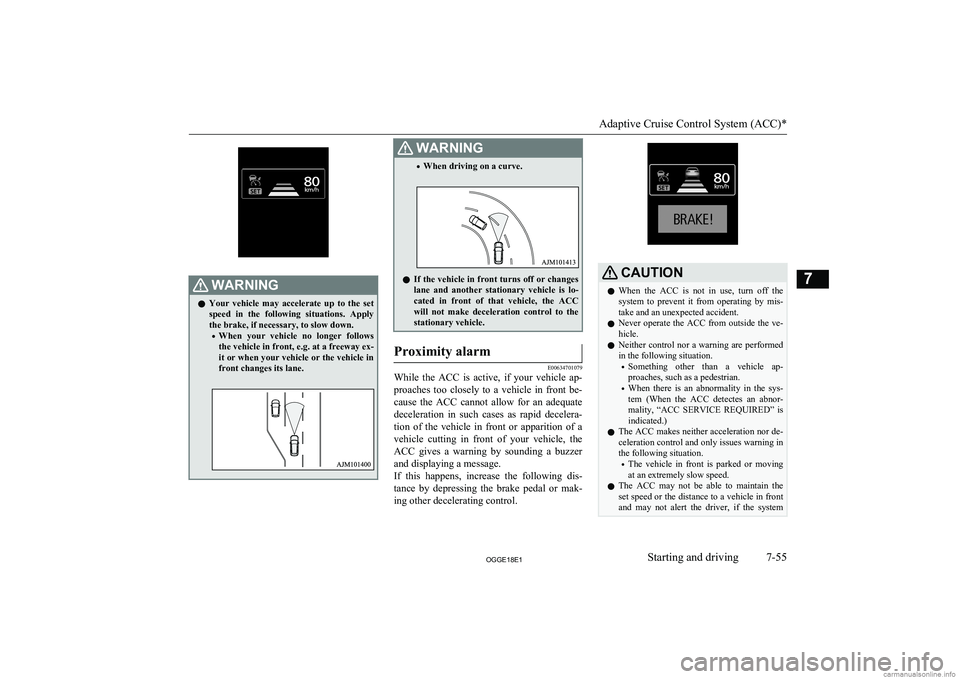
WARNINGlYour vehicle may accelerate up to the set
speed in the following situations. Apply the brake, if necessary, to slow down.
• When your vehicle no longer follows
the vehicle in front, e.g. at a freeway ex-it or when your vehicle or the vehicle in
front changes its lane.WARNING• When driving on a curve.
l If the vehicle in front turns off or changes
lane and another stationary vehicle is lo- cated in front of that vehicle, the ACCwill not make deceleration control to the
stationary vehicle.
Proximity alarm
E00634701079
While the ACC is active, if your vehicle ap-
proaches too closely to a vehicle in front be-cause the ACC cannot allow for an adequate
deceleration in such cases as rapid decelera-
tion of the vehicle in front or apparition of a vehicle cutting in front of your vehicle, the
ACC gives a warning by sounding a buzzer and displaying a message.
If this happens, increase the following dis-
tance by depressing the brake pedal or mak- ing other decelerating control.
CAUTIONl When the ACC is not in use, turn off the
system to prevent it from operating by mis-take and an unexpected accident.
l Never operate the ACC from outside the ve-
hicle.
l Neither control nor a warning are performed
in the following situation.
• Something other than a vehicle ap-
proaches, such as a pedestrian.
• When there is an abnormality in the sys-
tem (When the ACC detectes an abnor-mality, “ACC SERVICE REQUIRED” is
indicated.)
l The ACC makes neither acceleration nor de-
celeration control and only issues warning inthe following situation.
• The vehicle in front is parked or moving
at an extremely slow speed.
l The ACC may not be able to maintain the
set speed or the distance to a vehicle in front
and may not alert the driver, if the system
Adaptive Cruise Control System (ACC)*
7-55OGGE18E1Starting and driving7
Page 270 of 538
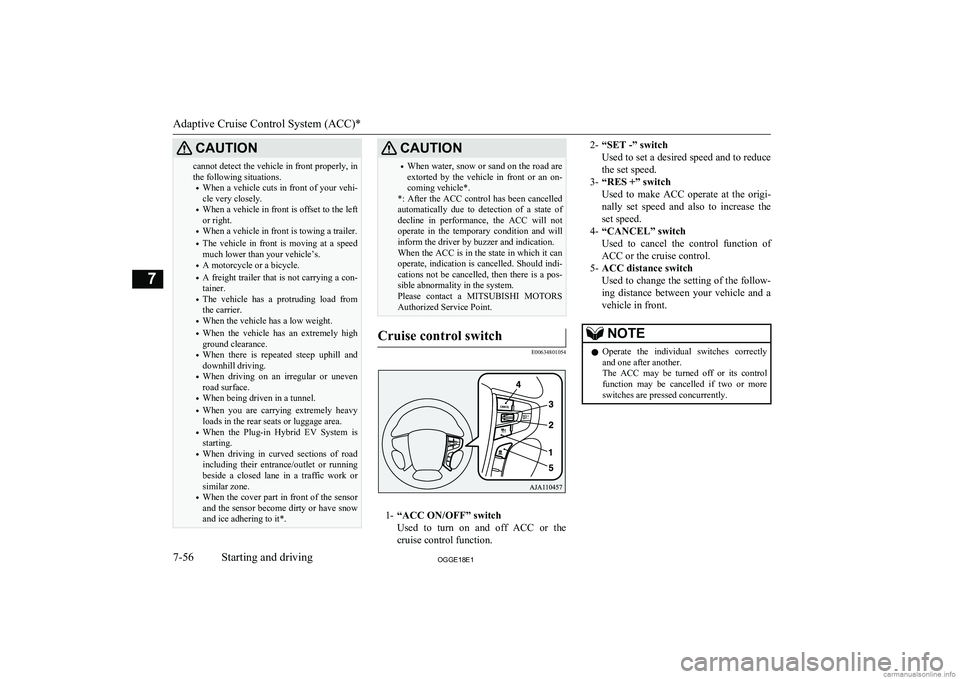
CAUTIONcannot detect the vehicle in front properly, in
the following situations.
• When a vehicle cuts in front of your vehi-
cle very closely.
• When a vehicle in front is offset to the left
or right.
• When a vehicle in front is towing a trailer.
• The vehicle in front is moving at a speed
much lower than your vehicle’s.
• A motorcycle or a bicycle.
• A freight trailer that is not carrying a con-
tainer.
• The vehicle has a protruding load from
the carrier.
• When the vehicle has a low weight.
• When the vehicle has an extremely high
ground clearance.
• When there is repeated steep uphill and
downhill driving.
• When driving on an irregular or uneven
road surface.
• When being driven in a tunnel.
• When you are carrying extremely heavy
loads in the rear seats or luggage area.
• When the Plug-in Hybrid EV System is
starting.
• When driving in curved sections of road
including their entrance/outlet or running
beside a closed lane in a traffic work or
similar zone.
• When the cover part in front of the sensor
and the sensor become dirty or have snowand ice adhering to it*.CAUTION• When water, snow or sand on the road are
extorted by the vehicle in front or an on- coming vehicle*.
*: After the ACC control has been cancelled
automatically due to detection of a state of decline in performance, the ACC will notoperate in the temporary condition and will
inform the driver by buzzer and indication.
When the ACC is in the state in which it can
operate, indication is cancelled. Should indi- cations not be cancelled, then there is a pos- sible abnormality in the system.
Please contact a MITSUBISHI MOTORS
Authorized Service Point.Cruise control switch
E00634801054
1- “ACC ON/OFF” switch
Used to turn on and off ACC or the
cruise control function.
2- “SET -” switch
Used to set a desired speed and to reduce the set speed.
3- “RES +” switch
Used to make ACC operate at the origi-
nally set speed and also to increase the set speed.
4- “CANCEL” switch
Used to cancel the control function of
ACC or the cruise control.
5- ACC distance switch
Used to change the setting of the follow-
ing distance between your vehicle and a
vehicle in front.NOTEl Operate the individual switches correctly
and one after another.
The ACC may be turned off or its control
function may be cancelled if two or more switches are pressed concurrently.
Adaptive Cruise Control System (ACC)*
7-56OGGE18E1Starting and driving7
Page 276 of 538
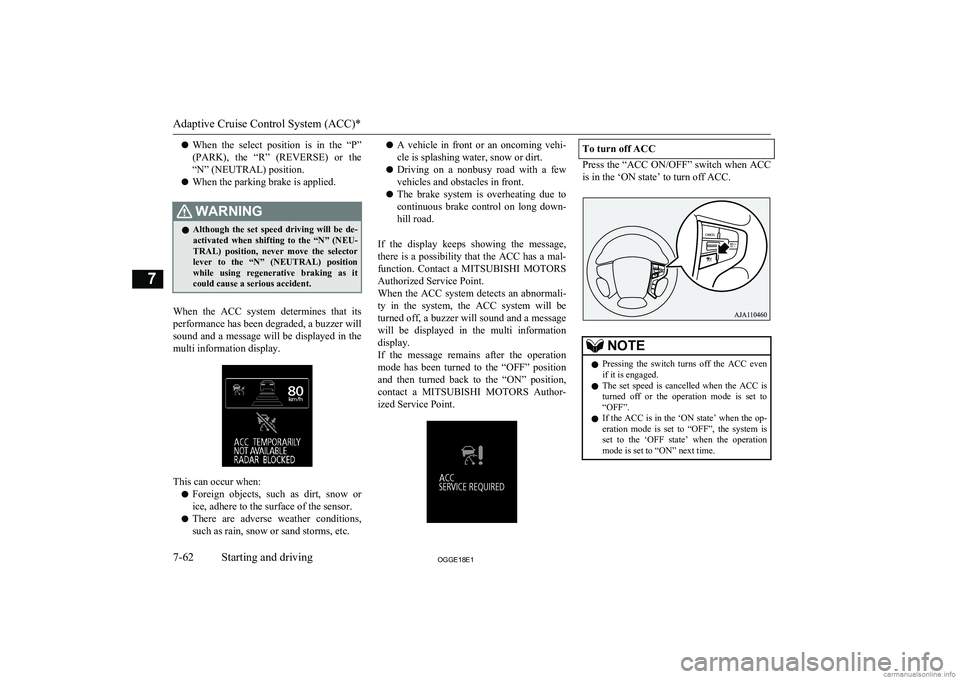
lWhen the select position is in the “P”
(PARK), the “R” (REVERSE) or the
“N” (NEUTRAL) position.
l When the parking brake is applied.WARNINGl Although the set speed driving will be de-
activated when shifting to the “N” (NEU-
TRAL) position, never move the selector lever to the “N” (NEUTRAL) position
while using regenerative braking as it could cause a serious accident.
When the ACC system determines that its
performance has been degraded, a buzzer will sound and a message will be displayed in the multi information display.
This can occur when:
l Foreign objects, such as dirt, snow or
ice, adhere to the surface of the sensor.
l There are adverse weather conditions,
such as rain, snow or sand storms, etc.
l A vehicle in front or an oncoming vehi-
cle is splashing water, snow or dirt.
l Driving on a nonbusy road with a few
vehicles and obstacles in front.
l The brake system is overheating due to
continuous brake control on long down- hill road.
If the display keeps showing the message,
there is a possibility that the ACC has a mal- function. Contact a MITSUBISHI MOTORS
Authorized Service Point.
When the ACC system detects an abnormali-
ty in the system, the ACC system will be turned off, a buzzer will sound and a message
will be displayed in the multi information display.
If the message remains after the operation mode has been turned to the “OFF” position
and then turned back to the “ON” position, contact a MITSUBISHI MOTORS Author-
ized Service Point.To turn off ACC
Press the “ACC ON/OFF” switch when ACC
is in the ‘ON state’ to turn off ACC.
NOTEl Pressing the switch turns off the ACC even
if it is engaged.
l The set speed is cancelled when the ACC is
turned off or the operation mode is set to
“OFF”.
l If the ACC is in the ‘ON state’ when the op-
eration mode is set to “OFF”, the system is set to the ‘OFF state’ when the operation
mode is set to “ON” next time.
Adaptive Cruise Control System (ACC)*
7-62OGGE18E1Starting and driving7
Page 284 of 538
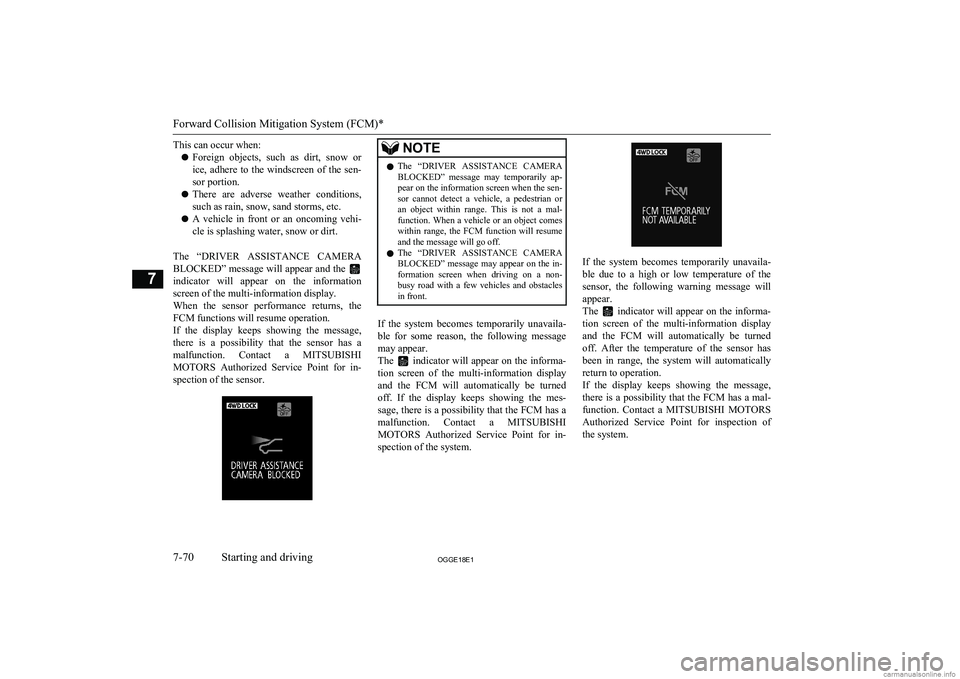
This can occur when:l Foreign objects, such as dirt, snow or
ice, adhere to the windscreen of the sen-
sor portion.
l There are adverse weather conditions,
such as rain, snow, sand storms, etc.
l A vehicle in front or an oncoming vehi-
cle is splashing water, snow or dirt.
The “DRIVER ASSISTANCE CAMERA BLOCKED” message will appear and the
indicator will appear on the information screen of the multi-information display.
When the sensor performance returns, the
FCM functions will resume operation.
If the display keeps showing the message,
there is a possibility that the sensor has a malfunction. Contact a MITSUBISHI
MOTORS Authorized Service Point for in-
spection of the sensor.
NOTEl The “DRIVER ASSISTANCE CAMERA
BLOCKED” message may temporarily ap-
pear on the information screen when the sen-
sor cannot detect a vehicle, a pedestrian or an object within range. This is not a mal-
function. When a vehicle or an object comes within range, the FCM function will resume
and the message will go off.
l The “DRIVER ASSISTANCE CAMERA
BLOCKED” message may appear on the in- formation screen when driving on a non-busy road with a few vehicles and obstacles
in front.
If the system becomes temporarily unavaila-
ble for some reason, the following message
may appear.
The
indicator will appear on the informa-
tion screen of the multi-information display
and the FCM will automatically be turned off. If the display keeps showing the mes-
sage, there is a possibility that the FCM has a
malfunction. Contact a MITSUBISHI
MOTORS Authorized Service Point for in-
spection of the system.
If the system becomes temporarily unavaila-
ble due to a high or low temperature of the
sensor, the following warning message will
appear.
The
indicator will appear on the informa-
tion screen of the multi-information display
and the FCM will automatically be turned off. After the temperature of the sensor has
been in range, the system will automatically
return to operation.
If the display keeps showing the message, there is a possibility that the FCM has a mal-
function. Contact a MITSUBISHI MOTORS
Authorized Service Point for inspection of
the system.
Forward Collision Mitigation System (FCM)*
7-70OGGE18E1Starting and driving7
Page 285 of 538
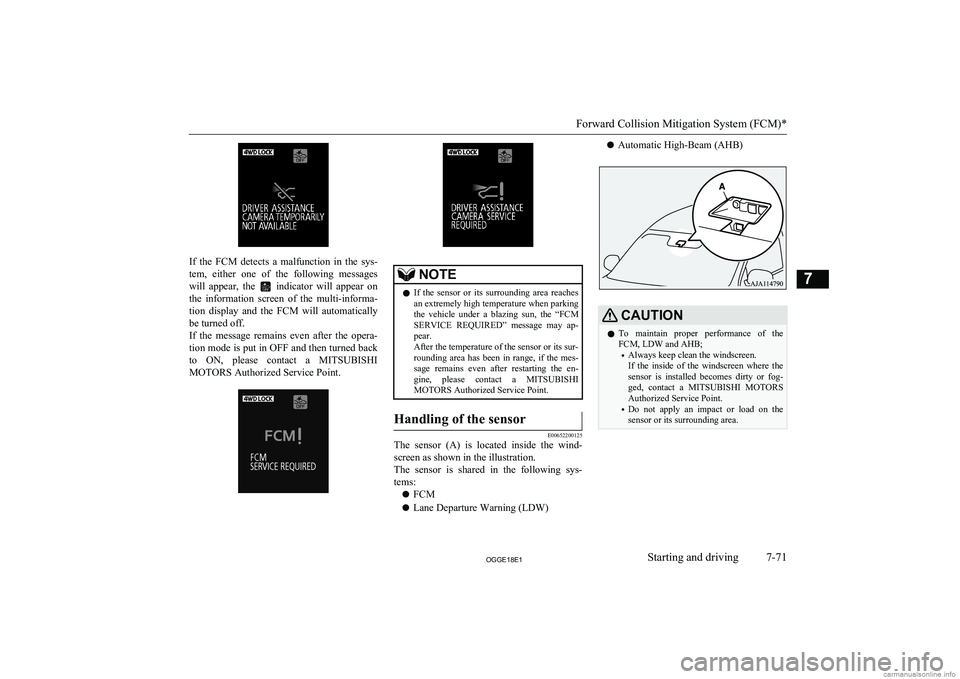
If the FCM detects a malfunction in the sys-
tem, either one of the following messages
will appear, the
indicator will appear on
the information screen of the multi-informa-
tion display and the FCM will automatically
be turned off.
If the message remains even after the opera- tion mode is put in OFF and then turned back to ON, please contact a MITSUBISHI
MOTORS Authorized Service Point.
NOTEl If the sensor or its surrounding area reaches
an extremely high temperature when parking the vehicle under a blazing sun, the “FCMSERVICE REQUIRED” message may ap-
pear.
After the temperature of the sensor or its sur-
rounding area has been in range, if the mes-
sage remains even after restarting the en-
gine, please contact a MITSUBISHI
MOTORS Authorized Service Point.Handling of the sensor
E00652200125
The sensor (A) is located inside the wind-
screen as shown in the illustration.
The sensor is shared in the following sys- tems:
l FCM
l Lane Departure Warning (LDW)
l Automatic High-Beam (AHB)CAUTIONlTo maintain proper performance of the
FCM, LDW and AHB;
• Always keep clean the windscreen.
If the inside of the windscreen where the
sensor is installed becomes dirty or fog- ged, contact a MITSUBISHI MOTORS
Authorized Service Point.
• Do not apply an impact or load on the
sensor or its surrounding area.
Forward Collision Mitigation System (FCM)*
7-71OGGE18E1Starting and driving7
Page 286 of 538

CAUTION•Do not put anything including a sticker or
film to the outer side of the windscreen in front of or surrounding area of the sensor.
Also, do not put anything including a sticker or film on the both inner and outer
side of the windscreen under the sensor.
• Do not attempt to detach or disassemble
the sensor.
• If the windscreen is misted, remove the
mist from the windscreen by using the de-
mister switch.
• Maintain the wiper blades in good condi-
tion.
Refer to “Wiper blades” on page 10-06.
When replacing the wiper blades, use on-
ly MITSUBISHI MOTORS GENUINE
parts or equivalent.
• Do not dirty or damage the sensor.
• Do not spray glass cleaner on the sensor.
Also, do not spill liquid, such as a bever- age, on the sensor.
• Do not install an electronic device, such
as an antenna, or a device that emits
strong electric waves near the sensor.
CAUTION• Always use tyres of the same size, same
type and same brand and that have no sig-
nificant wear differences.
• Do not modify the vehicle’s suspensions.
l If the windscreen on the sensor or in the sur-
rounding area of the sensor is cracked or
scratched, the sensor may not detect an ob- ject properly. This could cause a serious ac-cident. Turn off the FCM and have your ve- hicle inspected as soon as possible at a
MITSUBISHI MOTORS Authorized Serv-
ice Point.
If you need to replace the windscreen, con-
tact a MITSUBISHI MOTORS Authorized
Service Point.
l The sensor emits infrared rays when the op-
eration mode is in ON. Do not look into the sensor by using optical goods such as a mag-
nifying glass. The infrared ray might injure your eyes.
Laser radar specifications
Laser classification
Max average power45 mWPulse duration33 nsWavelength905 nmDivergent angle (ho-
rizon x vertical)28° x 12°Laser classification label
For Europe
For Kazakhstan and Belarus
For Israel
Forward Collision Mitigation System (FCM)*
7-72OGGE18E1Starting and driving7
Page 292 of 538
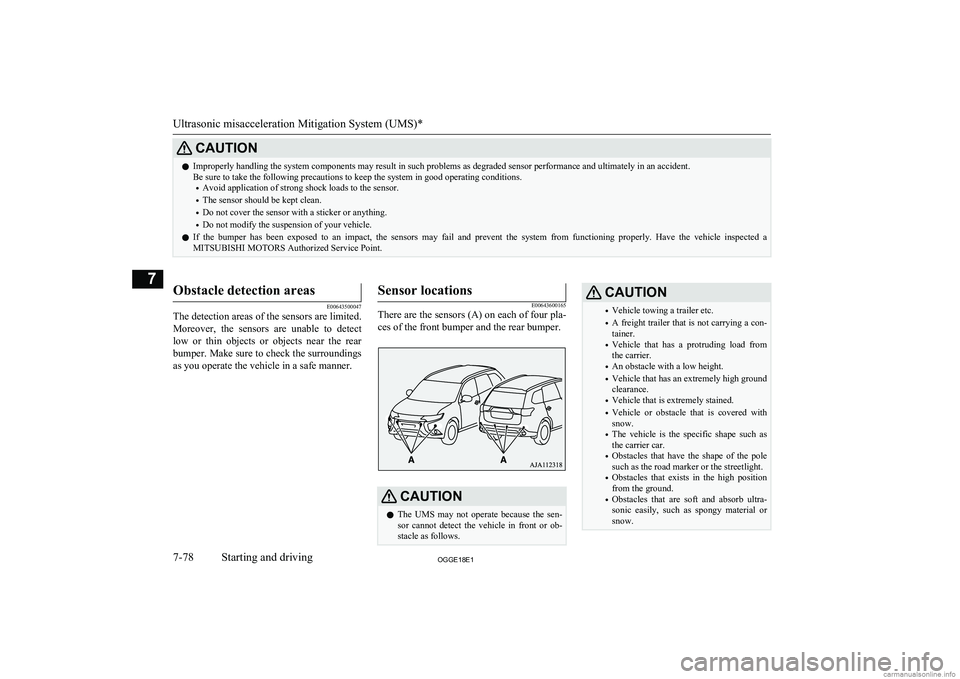
CAUTIONlImproperly handling the system components may result in such problems as degraded sensor performance and ultimately in an accident.
Be sure to take the following precautions to keep the system in good operating conditions.
• Avoid application of strong shock loads to the sensor.
• The sensor should be kept clean.
• Do not cover the sensor with a sticker or anything.
• Do not modify the suspension of your vehicle.
l If the bumper has been exposed to an impact, the sensors may fail and prevent the system from functioning properly. Have the vehicle inspected a
MITSUBISHI MOTORS Authorized Service Point.
Obstacle detection areas
E00643500047
The detection areas of the sensors are limited.
Moreover, the sensors are unable to detect
low or thin objects or objects near the rear
bumper. Make sure to check the surroundings
as you operate the vehicle in a safe manner.
Sensor locations
E00643600165
There are the sensors (A) on each of four pla-
ces of the front bumper and the rear bumper.CAUTIONl The UMS may not operate because the sen-
sor cannot detect the vehicle in front or ob-
stacle as follows.CAUTION• Vehicle towing a trailer etc.
• A freight trailer that is not carrying a con-
tainer.
• Vehicle that has a protruding load from
the carrier.
• An obstacle with a low height.
• Vehicle that has an extremely high ground
clearance.
• Vehicle that is extremely stained.
• Vehicle or obstacle that is covered with
snow.
• The vehicle is the specific shape such as
the carrier car.
• Obstacles that have the shape of the pole
such as the road marker or the streetlight.
• Obstacles that exists in the high position
from the ground.
• Obstacles that are soft and absorb ultra-
sonic easily, such as spongy material or
snow.
Ultrasonic misacceleration Mitigation System (UMS)*
7-78OGGE18E1Starting and driving7
Page 293 of 538
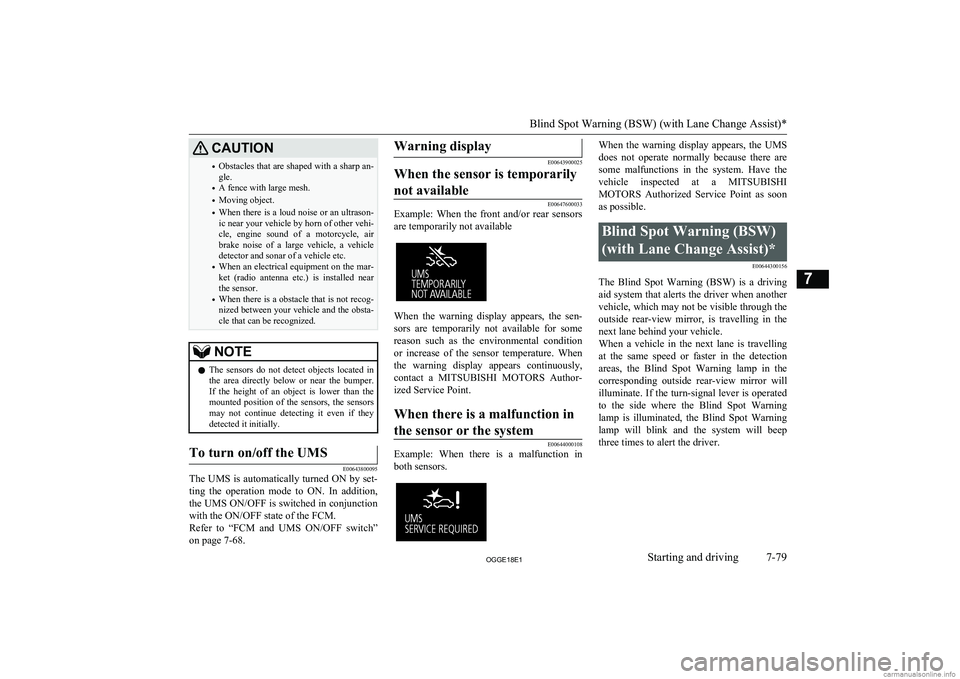
CAUTION•Obstacles that are shaped with a sharp an-
gle.
• A fence with large mesh.
• Moving object.
• When there is a loud noise or an ultrason-
ic near your vehicle by horn of other vehi-
cle, engine sound of a motorcycle, air brake noise of a large vehicle, a vehicle
detector and sonar of a vehicle etc.
• When an electrical equipment on the mar-
ket (radio antenna etc.) is installed near
the sensor.
• When there is a obstacle that is not recog-
nized between your vehicle and the obsta- cle that can be recognized.NOTEl The sensors do not detect objects located in
the area directly below or near the bumper. If the height of an object is lower than the
mounted position of the sensors, the sensors
may not continue detecting it even if they detected it initially.To turn on/off the UMS
E00643800095
The UMS is automatically turned ON by set-
ting the operation mode to ON. In addition,
the UMS ON/OFF is switched in conjunction with the ON/OFF state of the FCM.
Refer to “FCM and UMS ON/OFF switch” on page 7-68.
Warning display
E00643900025
When the sensor is temporarily
not available
E00647600033
Example: When the front and/or rear sensors
are temporarily not available
When the warning display appears, the sen- sors are temporarily not available for somereason such as the environmental condition
or increase of the sensor temperature. When
the warning display appears continuously,
contact a MITSUBISHI MOTORS Author-
ized Service Point.
When there is a malfunction in
the sensor or the system
E00644000108
Example: When there is a malfunction in both sensors.
When the warning display appears, the UMS
does not operate normally because there are some malfunctions in the system. Have the
vehicle inspected at a MITSUBISHI
MOTORS Authorized Service Point as soon
as possible.Blind Spot Warning (BSW)
(with Lane Change Assist)* E00644300156
The Blind Spot Warning (BSW) is a drivingaid system that alerts the driver when anothervehicle, which may not be visible through the outside rear-view mirror, is travelling in the
next lane behind your vehicle.
When a vehicle in the next lane is travelling at the same speed or faster in the detection areas, the Blind Spot Warning lamp in the
corresponding outside rear-view mirror will illuminate. If the turn-signal lever is operated
to the side where the Blind Spot Warning
lamp is illuminated, the Blind Spot Warning lamp will blink and the system will beepthree times to alert the driver.
Blind Spot Warning (BSW) (with Lane Change Assist)*
7-79OGGE18E1Starting and driving7
Page 295 of 538
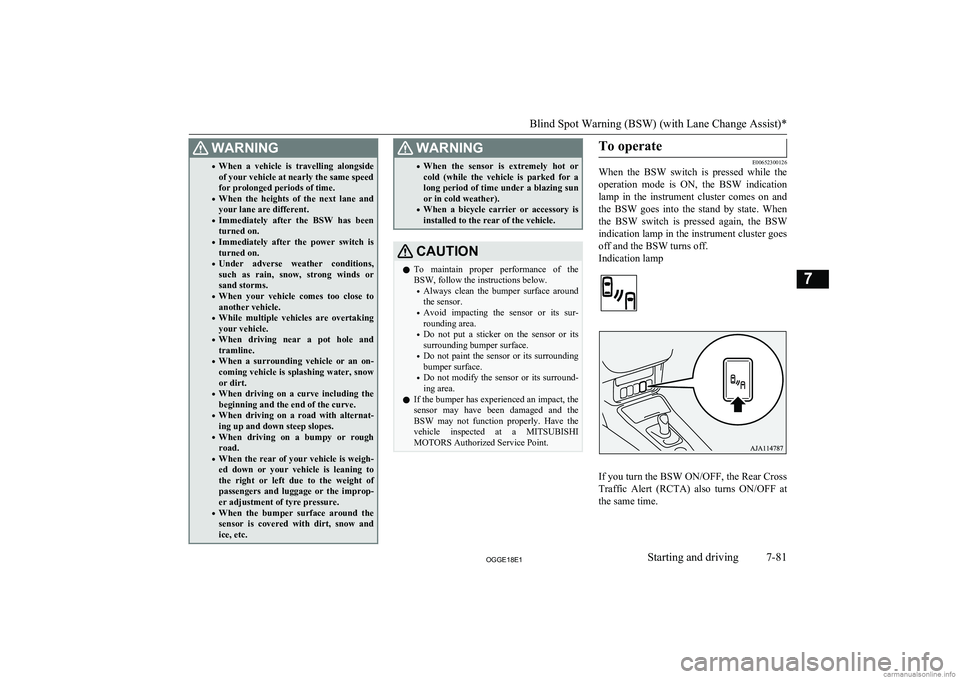
WARNING•When a vehicle is travelling alongside
of your vehicle at nearly the same speed
for prolonged periods of time.
• When the heights of the next lane and
your lane are different.
• Immediately after the BSW has been
turned on.
• Immediately after the power switch is
turned on.
• Under adverse weather conditions,
such as rain, snow, strong winds or
sand storms.
• When your vehicle comes too close to
another vehicle.
• While multiple vehicles are overtaking
your vehicle.
• When driving near a pot hole and
tramline.
• When a surrounding vehicle or an on-
coming vehicle is splashing water, snow or dirt.
• When driving on a curve including the
beginning and the end of the curve.
• When driving on a road with alternat-
ing up and down steep slopes.
• When driving on a bumpy or rough
road.
• When the rear of your vehicle is weigh-
ed down or your vehicle is leaning to
the right or left due to the weight of passengers and luggage or the improp-
er adjustment of tyre pressure.
• When the bumper surface around the
sensor is covered with dirt, snow and
ice, etc.WARNING• When the sensor is extremely hot or
cold (while the vehicle is parked for a
long period of time under a blazing sun or in cold weather).
• When a bicycle carrier or accessory is
installed to the rear of the vehicle.CAUTIONl To maintain proper performance of the
BSW, follow the instructions below.
• Always clean the bumper surface around
the sensor.
• Avoid impacting the sensor or its sur-
rounding area.
• Do not put a sticker on the sensor or its
surrounding bumper surface.
• Do not paint the sensor or its surrounding
bumper surface.
• Do not modify the sensor or its surround-
ing area.
l If the bumper has experienced an impact, the
sensor may have been damaged and the
BSW may not function properly. Have the
vehicle inspected at a MITSUBISHI
MOTORS Authorized Service Point.To operate
E00652300126
When the BSW switch is pressed while the
operation mode is ON, the BSW indication
lamp in the instrument cluster comes on and the BSW goes into the stand by state. When the BSW switch is pressed again, the BSW
indication lamp in the instrument cluster goes
off and the BSW turns off.
Indication lamp
If you turn the BSW ON/OFF, the Rear Cross Traffic Alert (RCTA) also turns ON/OFF at the same time.
Blind Spot Warning (BSW) (with Lane Change Assist)*
7-81OGGE18E1Starting and driving7
Page 297 of 538

When the warning display appears, the BSWdoes not operate normally because there are
some malfunctions in the system or the sen- sor. Have the vehicle inspected at a
MITSUBISHI MOTORS Authorized Service
Point as soon as possible.NOTEl When the warning display appears, the BSW
will be deactivated.When the sensor is temporarily
not available
E00692700021
When the warning display appears, the sensor
is temporarily not available for some reason such as the environmental condition or in-
crease of the sensor temperature. When the warning display does not disappear after waiting for a while, contact a MITSUBISHI
MOTORS Authorized Service Point.
When there is are foreign ob-
jects on the sensor
E00692800022
When the warning display appears, the sensor
cannot detect a vehicle travelling side by side or an approaching vehicle, because foreignobjects, such as dirt, snow or ice, adhere to the bumper surface around the sensor.Remove dirt, freezing or foreign material on
the bumper surface around the sensor.
When the warning display does not disappear after having cleaned the sensor, contact a
MITSUBISHI MOTORS Authorized Service
Point.
Rear Cross Traffic Alert
(RCTA)* E00652400097
The Rear Cross Traffic Alert (RCTA) is an aid system for backing up. When the RCTA system detects vehicles approaching from
sides while your vehicle is reversing, the
Blind Spot Warning lamps in the outside rear-view mirrors on both sides will blink anda buzzer will sound to alert the driver. A
warning message will also appear on the in-
formation screen of the multi-information display.
Rear Cross Traffic Alert (RCTA)*
7-83OGGE18E1Starting and driving7